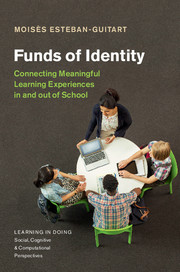Book contents
- Funds of Identity
- Learning in Doing: Social, Cognitive, and Computational Perspectives
- Funds of Identity
- Copyright page
- Contents
- Figures
- Tables
- Book part
- My Own Funds of Identity
- 1 Learning in a Mobile-Centric Society
- 2 From Funds of Knowledge to Funds of Identity
- 3 How to Detect Funds of Identity?
- 4 How to Use Students’ Funds of Identity Pedagogically
- Identities at the Heart of Education
- References
- Index
- References
References
Published online by Cambridge University Press: 05 August 2016
- Funds of Identity
- Learning in Doing: Social, Cognitive, and Computational Perspectives
- Funds of Identity
- Copyright page
- Contents
- Figures
- Tables
- Book part
- My Own Funds of Identity
- 1 Learning in a Mobile-Centric Society
- 2 From Funds of Knowledge to Funds of Identity
- 3 How to Detect Funds of Identity?
- 4 How to Use Students’ Funds of Identity Pedagogically
- Identities at the Heart of Education
- References
- Index
- References
- Type
- Chapter
- Information
- Funds of IdentityConnecting Meaningful Learning Experiences in and out of School, pp. 111 - 122Publisher: Cambridge University PressPrint publication year: 2016



